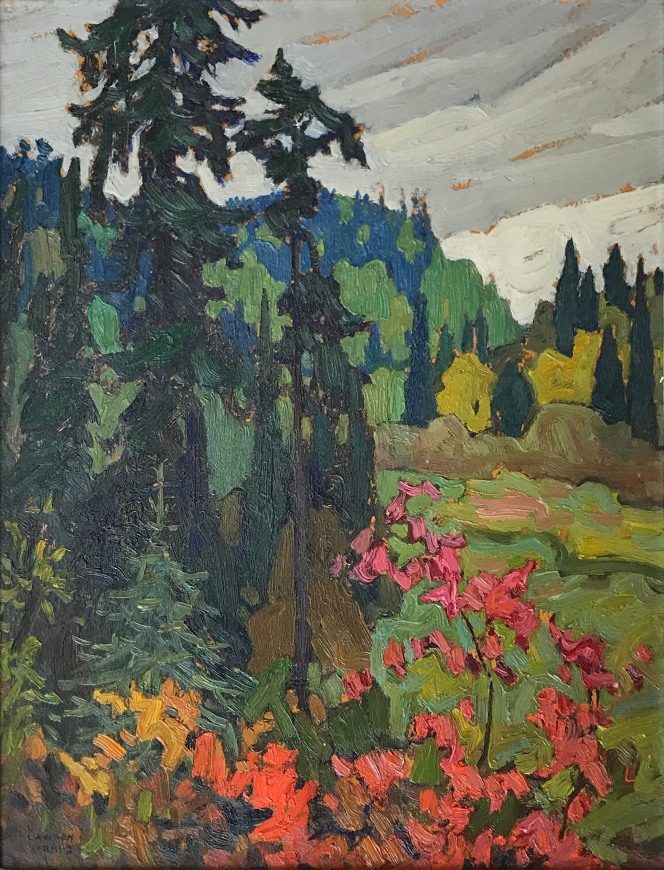-
Artworks
Lawren S. HarrisHubert (Algoma Sketch), 1918 (circa)1885-1970Oil on Beaverboard13 5/8 x 10 1/2 in
34.6 x 26.7 cmSoldInscriptions
signed, ‘LAWREN / HARRIS’ (lower left); inscribed by the artist, ‘Hubert/ lawren Harris’ (verso, upper left); marked in ballpoint pen ‘8032-S’ (verso, upper left); marked in graphite ‘206’ (encircled) (verso, centre); printed label, ‘C 2082 / Price’ (crossed out in ink) (verso, centre); inscribed in black marker, cross in a circle (verso, lower left)Provenance
The Collection of Mitzi and Mel Dobrin.
Exhibitions
Toronto, Alan Klinkhoff Gallery, Lawren Harris & Canadian Masters: Historic Sale Celebrating Canada's 150 Years, April 1, 2017.Lawren Harris first travelled to the Algoma region north of Sault Ste. Marie in May 1918 following his demobilization from the army. He travelled with Dr. James MacCallum, co-financier of the Studio Building in Toronto. They first explored Manitoulin Island then moved on to Sault Ste. Marie and boarded the Algoma Central Railway travelling as far as Mile 129, returning via Michipicoten Harbour on Lake Superior. As he later reminisced in an address to the Canadian Historical Society in 1948, “We found Algoma a rugged, wildland packed with an amazing variety of subjects. It was a veritable paradise for the creative adventurer in paint in the Canadian north.”
In September 1918 Harris and MacCallum returned to Algoma, this time travelling with Frank Johnston and J.E.H. MacDonald. Harris described the arrangements in a letter to MacDonald. “The trip – overnight on C.P.R. to the Soo. Next day at the Soo we enter a caboose which will be our home while in the North. Said caboose is hitched on to some train or other, hauled to a siding in the Agawa Canyon 120 miles north of the Soo and left there for two or three days while we proceed to get a stranglehold on the surroundings. From mile 120 we are picked up by a down-going train and left on another siding for a few days and again picked up and left on another siding and so on until we land in the Soo with a mass of sketches and C.P.R. ourselves home again.”
In his 1978 monograph on J.E.H. MacDonald, Paul Duval quotes the latter’s enthusiastic response to his first encounter with the Algoma landscapes, writing from Agawa Station, “The leaves are turning very slowly… We leave for Hubert in the morning.”
The results of this trip, and canvases painted in Toronto during the winter, were shown in a three-man exhibition at the Art Museum of Toronto in April 1919. The “Algoma Sketches and Pictures” were arranged chronologically and geographically following the advance of the autumn colour from Canyon, to Hubert, to Batchewana. In the corners of the museum’s galleries they displayed “Algomaxims,” challenging their viewers and critics. Harris exhibited eleven sketches painted in the vicinity of Hubert near the Montreal Falls on the Montreal River, the subject identified by Harris on the back of this sketch.
Harris returned to Algoma in the fall of 1919, painting at Hubert once more with MacDonald and Johnston, as well as A.Y. Jackson, recently demobilized from the army. From a siding at Hubert, Jackson wrote to his cousin Florence Clement, “The color is disappearing very fast. The reds were gorgeous when we first came, but now it is all orange and yellow. … In spite of the bad weather, two sunny days in the twelve we have been here, we have done a lot of work, got soaked pretty often too, but the box car is very cosy and one can soon get dried out. .... MacDonald and Johnson (sic) are Christian Scientists and Harris a theosophist and they don't see much difference between rain and sunshine."
Harris exhibited no further sketches specifically identified as having been painted at Hubert so it is highly likely this sketch was painted in the fall of 1918 and was one of those exhibited with the “Algoma Sketches and Pictures.” The vertical format of the sketch, a format he occasionally used at this time in contrast to his usual horizontal compositions, also supports this proposal. It is painted on a composite wood pulp board marketed as Beaverboard, a Canadian patented building material used for wall construction that Harris used for many years.
Harris’ response to the changing colour and particular climatic conditions at Hubert are superbly expressed in this oil study. The energetically brushed red and orange foreground foliage sets off the taller dark green firs and blue hills beyond. The foreground leaves and foliage on the hills beyond are treated as simplified masses of paint. The grey clouds fly across the sky contrasting with the stillness of the foliated valley, evidence of one of the Algomaxims: “Get the habit of looking at the sky. It is the source of light and art.” And to close, “Do not take the paintings too seriously, rather let them take you.”
Charles C. Hill





